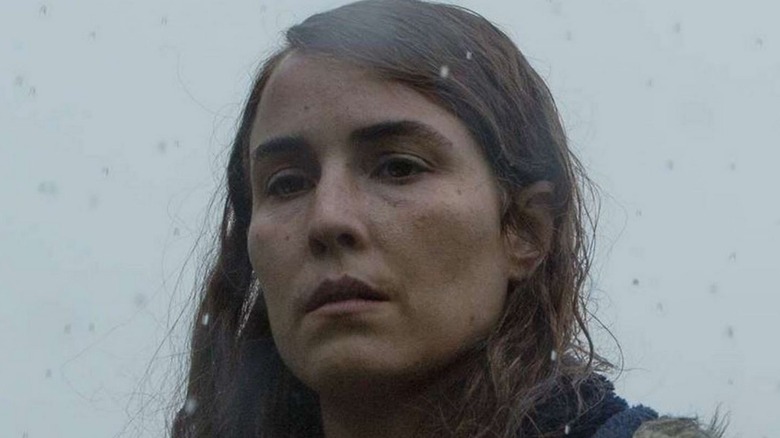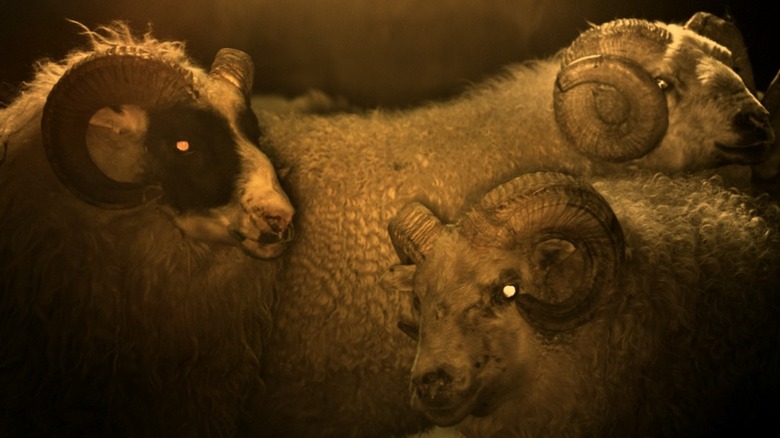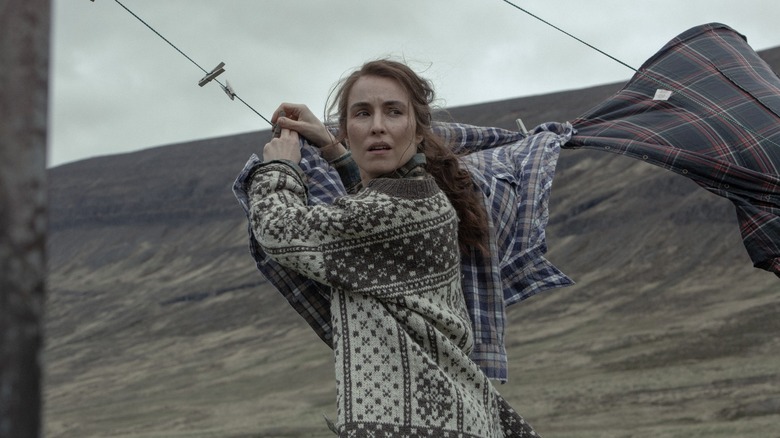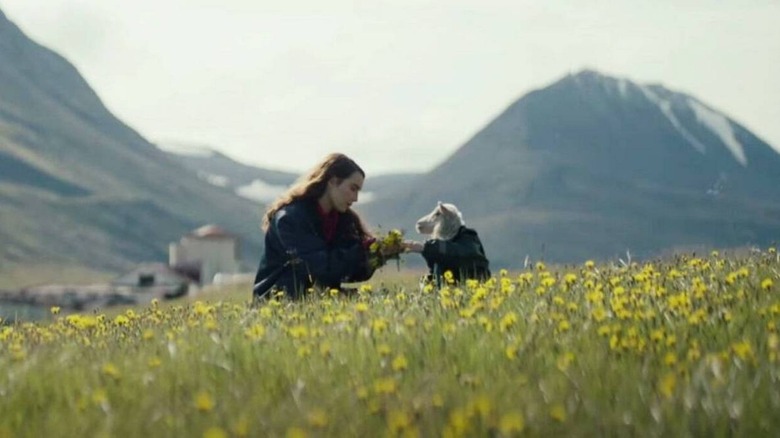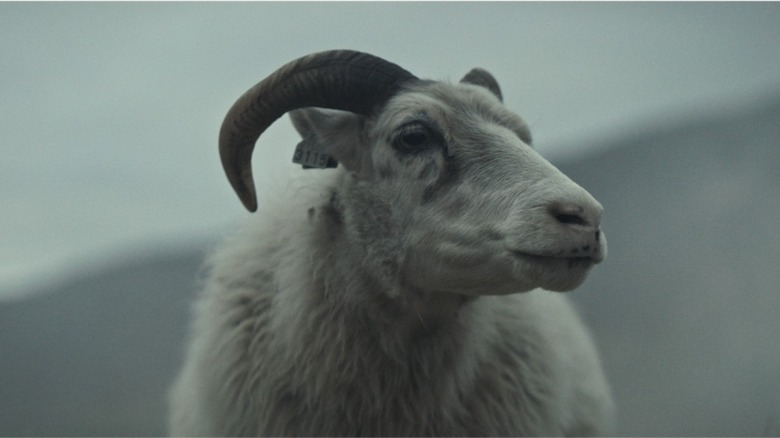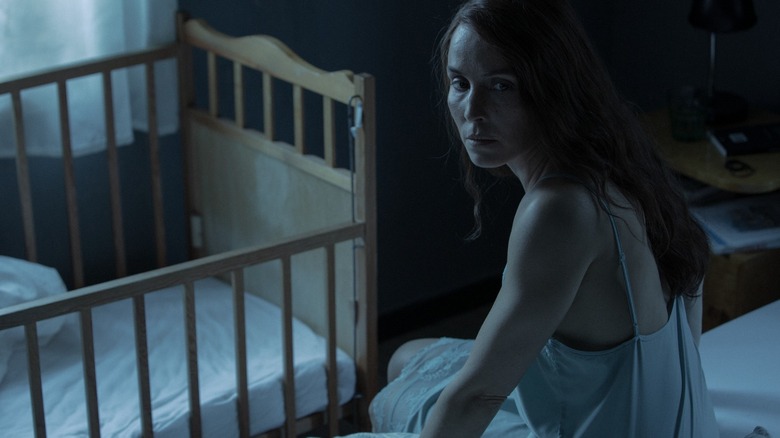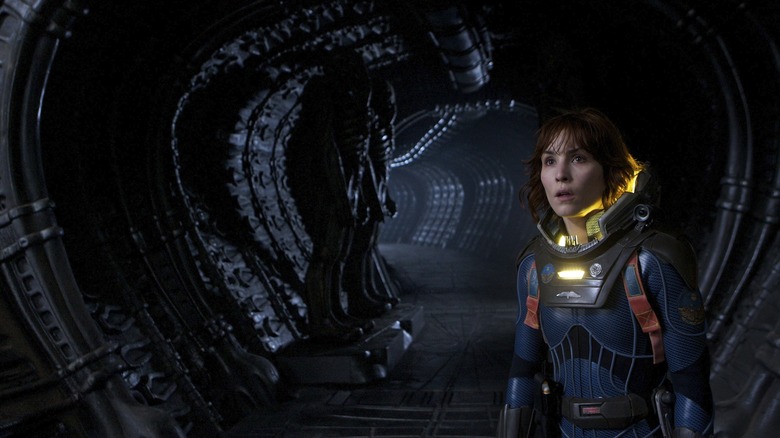Lamb Star Noomi Rapace And Director Valdimar Jóhannsson Dish On Their Haunting New Movie - Exclusive Interview
In the eerie new movie "Lamb," Swedish actor Noomi Rapace and Icelandic actor Hilmir Snær Guðnason play Maria and Ingvar, a couple who live and work on a sheep farm in the most remote region of Iceland, surrounded by nothing but mountains, animals and almost endless daylight. One day, one of their sheep gives birth to a bizarre creature that seems as if it's straight out of a folk tale. Unsure of what to do, they begin to raise the creature as their own, but forces both supernatural and human may interfere with their newfound happiness.
"Lamb," the feature directing debut of Icelandic filmmaker Valdimar Jóhannsson (who also co-wrote the script with Icelandic poet and author Sjón), is both a horror-tinged fable about the unearthly power of nature and a meditation on grief, loss and the pull of parental feelings. The location — a lonely farmhouse nestled in a vast stretch of the Icelandic wilderness — adds to the sense that Maria and Ingvar aren't even living on Earth, but in some fantastical realm. And their "child," named Ada, is brought to life through an unsettling mix of practical and digital effects.
Jóhannsson makes his directing debut after working as a technician on many films that have shot in Iceland, including "Prometheus," director Ridley Scott's 2012 semi-prequel to "Alien." That film, of course, starred Noomi Rapace, who had made her Hollywood breakthrough a year earlier on "Sherlock Holmes: A Game of Shadows," and appeared on the international radar by originating the role of Lisbeth Salander in the Swedish film adaptation of "The Girl with the Dragon Tattoo" and its sequels.
For Rapace, who grew up on a farm in Iceland, she felt an almost supernatural calling to do "Lamb," on which she is also a producer. Calling it a "dream project," she tells Looper in our interview, "It was almost like I didn't have a choice. It was like the project and Maria just had already chosen me."
Early inspirations for Lamb
Valdimar, is it true that the inspiration for this initially was just like a sketch that you drew one day. Is that correct?
Valdimar Jóhannsson: Yes. I made some kind of like a sketchbook or book, where I collect paintings, photos of the drawings, and trying to create a mood of a film that I really wanted to see.
Where did it go from there? Did you draw from folklore? How did you build out the story from there?
Jóhannsson: I met Sjón, and he's one of my favorite writers, and his books are usually ... You can always find something mythical, or he uses a lot of elements from folklore, and I thought he would be the right person to write the script with me, because he knows so much about it. And after I met him and showed him this [sketch] book, we started meeting every week, three or four hours, and came up with a story, making scenes from the images that we had collected.
How Lamb reached back to Noomi's childhood
Noomi, you spent quite a bit of time on a farm when you were younger. How did that experience help you connect with this character?
Noomi Rapace: I grew up on a farm, and it was a poor farm, far from everything. My best friends were my dog and my horse, my cat. So from a very early age, I would say that I developed this strong relationship to animals, and they were my family members.
I mean, I didn't deliver baby lambs, I didn't drive a tractor, and I didn't have a half-human/half-lamb child [laughs]. But in the sense of living in a place that is really remote and really closed off from the rest of the world, where there's animals and you find yourself being in the minority — like you're kind of living in the animal kingdom — that was how I grew up.
So I felt like, when Valdimar came to me with this project, I was invited to kind of revisit a place in myself that I haven't been for a long time, and I've been wanting and needing and longing to go back to. It felt like it was something I've always wanted and hoped for. The combination of the script, the complexity in Maria, and Valdimar's visual universe just made this a dream project for me. It was almost like I didn't have a choice. It was like the project and Maria just had already chosen me.
You did participate in a live birth during the filming of the movie.
Rapace: Several.
Jóhannsson: Yeah, she [drove the tractor] and delivered lambs.
Rapace: First day on set, my hands were pulling out a baby. It was the very end of lambing season, so I didn't have time. There was not a lot of practice or rehearsal.
What filming in a remote part of the world was like
Where was the location and what were the challenges there? In the film, it seems like it's so remote...
Jóhannsson: We were filming in the north of Iceland, at a house that nobody had lived in for over 20 years. It took us quite a long time to find the right location, because I had somehow imagined some special house. I think I drove two times around Iceland, calling farmers. But my brother found this one. It was not how I imagined, but somehow it was perfect, because of the layout and what was around it, all these mountains.
Rapace: It was really a powerful place. It was like [there were] a lot of strong energies in that valley. There was no phone signal. You were really cut off from the rest of the world, and it was an hour drive to the nearest gas station. So somehow with all of that, and the fact that we shot in Icelandic summer, when it never goes dark — it's like this strange daylight in the middle of the night — it felt like we all left the real world and lived in lamb world for that summer. It took over — I couldn't really function outside of our bubble. I didn't see anyone. I didn't talk to anyone. It was very much a surreal, but very real reality.
Jóhannsson: Yeah. We never had to wait for a car or an airplane [to pass by].
Rapace: There's nothing there.
Bringing the film's creature to life
Valdimar, what was your preferred method of bringing Ada to life? Did you go through a lot of tweaking of how she would look? What was the balance between practical and digital visual effects?
Jóhannsson: Before we started working on this project, somehow it started with just drawings of Ada. I think my first drawing or sketch of how she would look was so similar to how it ended up. And then we worked with children and lambs and also puppets. Then we just mixed all these elements together ... we never felt that she was not there when we were shooting.
Rapace: We shot with babies and lambs, and I was dancing and singing to a baby lamb, and then we switched her to a human baby. Somehow she was very much alive and present all the time.
It was a total waiting game for the lamb to fall asleep. Everyone had to go out. The whole crew had to wait outside. And then it was like, "Okay, the lamb is sleeping. Noomi, come in." And they kind of carefully handed over the lamb and were like [whispers], "Roll camera. Action." And then the baby lamb would open his eyes and start [makes sheep noises]. So everyone out, we had to start again, and 20 minutes later, he's sleeping [again]. So we totally had to surrender to the terms and conditions of the lambs and the baby's rhythms.
How working on Hollywood films influenced the director
Valdimar, before becoming a feature director, you worked on the crews of a number of Hollywood productions that came up to film in Iceland. How do you think that might have impacted you as you went forward in your own filmmaking career?
Jóhannsson: I worked with Noomi on "Prometheus" –
Rapace: He was handling the smoke, the fog.
Jóhannsson: But I think it's so nice to be a part of different projects, because you always see something new, and you can always learn something from other directors.
Rapace: That's something so amazing with you, that you know so much about each department on a film crew. This was your first feature, but because you worked in so many departments, you got everyone to feel really included. If the gaffer says that he needs five minutes, you know why. If the costume department needs something ... I felt like you managed to get everyone to feel like they were part of the family and really respected and included, because you know that they're not asking for anything extra, and you know so much about each field.
Noomi's strongest memory of working on Prometheus
Noomi, what do you remember best about "Prometheus"? That movie is coming up on its 10th anniversary and was a big one for you.
Rapace: Wow. I mean, amazing memories. First of all, the one thing that I carry with me on a daily basis is [director] Ridley Scott and how he embraced me. From the very first meeting we had, he said, "Don't change. Just be you. You have nothing to prove. I've chosen you. You don't even need to audition."
He just took me on board and said, "I want you to be you, be faithful to yourself." That was something I had with me throughout that journey and everything I do, to not lose myself. And I feel like, even when we were shooting out in the most kind of brutal environment in Iceland on "Prometheus," and I'm like this little creature against nature — it was a tough shoot — I had his voice always echoing in me: "Just be you, be faithful to you. Don't change." That was a great source to always find strength and to not lose yourself.
"Lamb" is out in theaters now.
